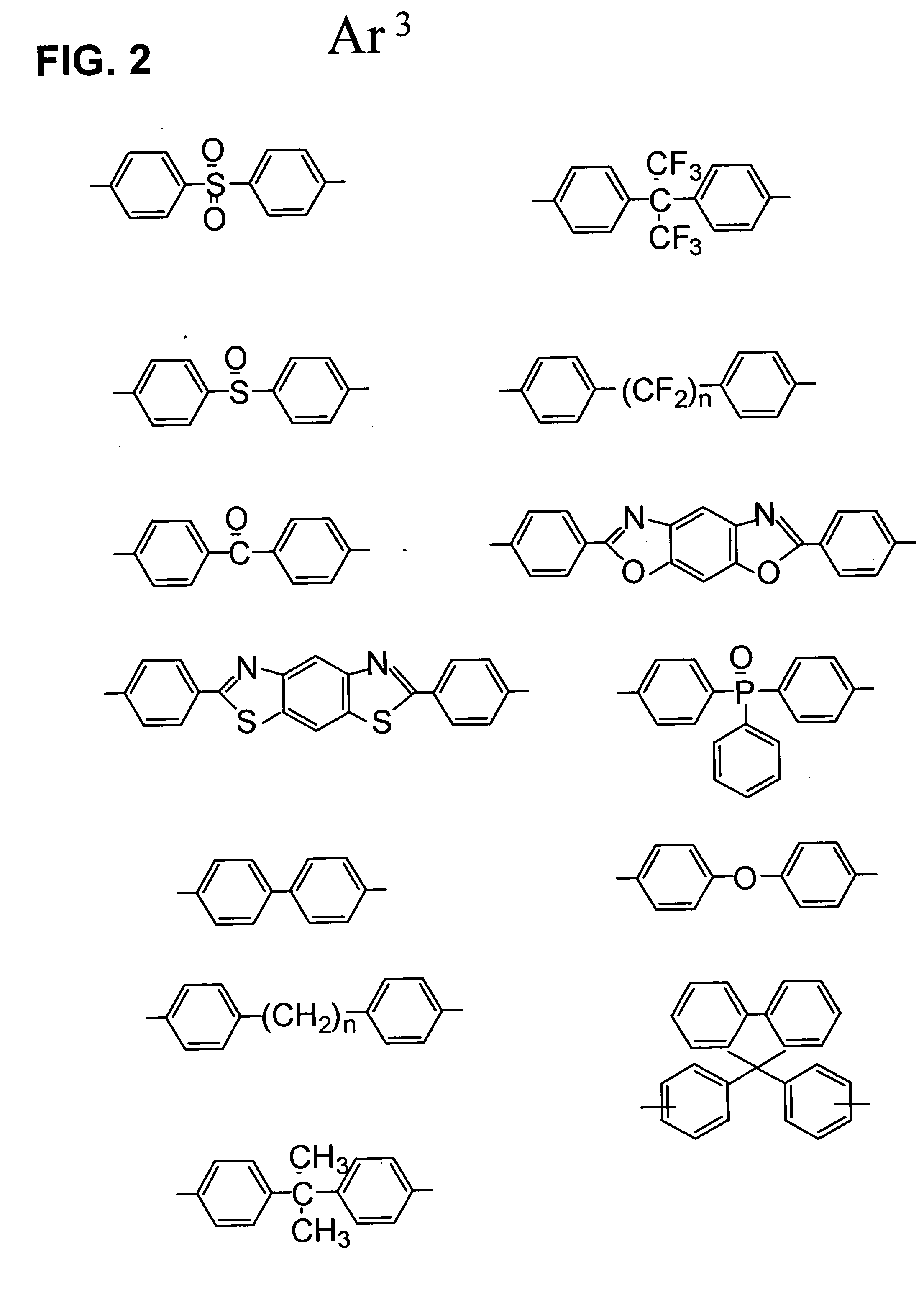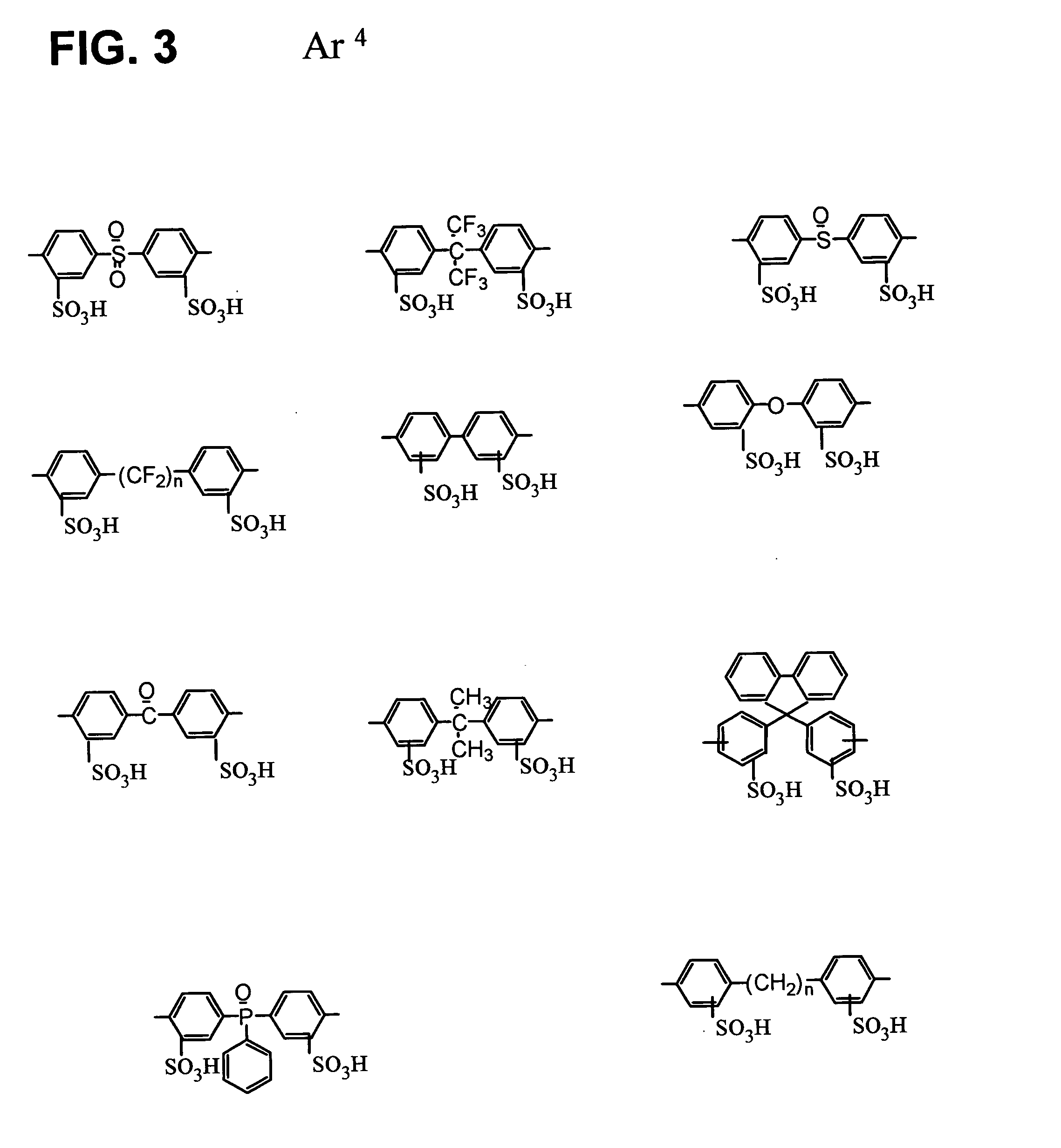Sulfonic acid group-containing, proton-conducting polymer composition, a solid electrolyte membrane and a solid polymer fuel cell
a proton-conducting polymer and solid electrolyte technology, which is applied in the direction of fuel cell details, cable/conductor manufacturing, final product manufacturing, etc., can solve the problems of inorganic dopants leaching out of the polymer, inability to draw out the energy of methanol as electric power, and high affinity of methanol, etc., to achieve low methanol cross-over, high proton conductivity, and low methanol cross-over
- Summary
- Abstract
- Description
- Claims
- Application Information
AI Technical Summary
Benefits of technology
Problems solved by technology
Method used
Image
Examples
example 1
Manufacuring of 2,4-dichloro-6-(4-thiomethylphenyl)-1,3,5-triazine (compound 1): FIG. 6
[0067] A solution obtained by dissolving 4-bromothioanisole (18.27 g, 0.09 mol) and magnesium (2.64 g, 0.11 mol) into tetrahydrofuran (THF) (200 mL), was stirred at 30° C. for two hours, and then, refluxed for another two hours. This solution was added to a solution of cyanuric chloride (21.58 g, 0.120 mol) in THF (200 mL) at −20° C., and the mixture was stirred at −20° C. for five hours.
[0068] The solvent was removed under a reduced pressure, the solid product thus formed was dissolved into dichloromethane, and washed with water twice. The organic layer was dried over anhydride MgSO4, and the solvent was distilled off.
[0069] The crude product was recrystallized in dichloromethane / n-hexane. The yield was 80%. 1H-NMR results (CDCl3, δ ppm): 8.41 (d, 2H, ArH-triazine), 7.33 (d, 2H, ArH-triazine), and 2.56 (s, 3H, SCH3).
example 2
Manufacuring of 4-benzyloxybromobenzene (compound 2): FIG. 6
[0070] To a solution composed of p-bromophenol (17.3 g, 0.1 mol) and dry DMF (100 mL), anhydride K2CO3 (8.28 g, 0.06 mmol) and benzyl bromide (25.6 g, 0.15 mmol) were added. The mixture was stirred at 80° C. under a nitrogen atmosphere for six hours. Then, the reaction mixture was charged into 500 mL of ice water.
[0071] The solid product was subjected to filtering with suction, drying and recrystallization in methanol. The yield was 85%. 1H-NMR results (CDCl3, δ ppm): 7.42-7.30 (m, 7H, ArH), 6.85 (d, 2H, ArH), and 5.02 (s, 2H, OCH2Ar).
example 3
Manufacturing of 2,4-bis(4-benzyloxyphenyl)-6-(4-thiomethylphenyl)-1,3,5-triazine (compound 3): FIG. 6
[0072] A THF solution (150 mL) of compound 1 (27.2 g, 0.1 mol) was added to a solution obtained by dissolving 4-benzyloxyphenylmagnesium bromide prepared from compound 2 (78.9 g, 0.30 mol) and magnesium (7.92 g, 0.33 mol), into THF (300 mL). The mixture was refluxed for ten hours, and then, the solvent was removed under a reduced pressure. The remaining solid was dissolved into dichloromethane, and washed with water twice. The organic layer was dried over anhydride MgSO4, and the solvent was distilled off.
[0073] The crude product was purified by column chromatography on silica gel, using hexane / methylene chloride (volume ratio=1:1) as a solvent. The yield was 60%. 1H-NMR results (CDCl3, δ ppm): 8.68 (d, 4H, ArH-triazine), 8.28 (d, 2H, ArH-triazine), 7.49-7.36 (m, 12H, ArH), 7.06 (d, 4H, ArH-triazine), 5.17 (s, 4H, OCH2Ar), and 2.55 (s, 3H, CH3).
PUM
| Property | Measurement | Unit |
|---|---|---|
| temperature | aaaaa | aaaaa |
| concentration | aaaaa | aaaaa |
| gap size | aaaaa | aaaaa |
Abstract
Description
Claims
Application Information
 Login to View More
Login to View More - R&D
- Intellectual Property
- Life Sciences
- Materials
- Tech Scout
- Unparalleled Data Quality
- Higher Quality Content
- 60% Fewer Hallucinations
Browse by: Latest US Patents, China's latest patents, Technical Efficacy Thesaurus, Application Domain, Technology Topic, Popular Technical Reports.
© 2025 PatSnap. All rights reserved.Legal|Privacy policy|Modern Slavery Act Transparency Statement|Sitemap|About US| Contact US: help@patsnap.com



